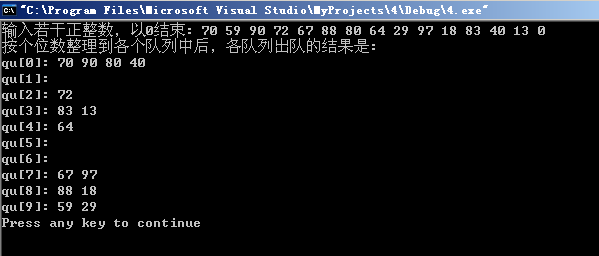第七周项目4-队列数组
2016-10-20 10:47
99 查看
问题及代码:
/*
Copyright (c)2016,烟台大学计算机与控制工程学院
All rights reserved.
文件名称:4.cpp
作 者:孙子晴
完成日期:2016年10月20日
版 本 号:v1.0
问题描述:创建10个队列,分别编号为0-9(处理为队列数组,编号即下标)。输入若干个正整数,以数字0作
为结束。设输入的值为x,其个位数字的大小为i,则将x插入到编号为i的队列中。最后输出所有的
非空队列。 要求将队列处理成链式队列,使用链式队列算法库中定义的数据类型及算法,程序中只
包括一个函数(main函数),入队和出队等操作直接在main函数中调用即可。
输入描述:若干整数
程序输出:0-9队列出队结果
*/ liqueue.h:
#ifndef LIQUEUE_H_INCLUDED
#define LIQUEUE_H_INCLUDED
#include <malloc.h>
#define MaxSize 5
typedef int ElemType;
typedef struct qnode //数据节点
{
ElemType data;
struct qnode *next;
} QNode;
typedef struct //链队节点
{
QNode *front;
QNode *rear;
} LiQueue;
void InitQueue(LiQueue *&q); //初始化链队
void DestroyQueue(LiQueue *&q); //销毁链队
bool QueueEmpty(LiQueue *q); //判断链队是否为空
int QueueLength(LiQueue *q); //返回队列中元素个数,也称队列长度
void enQueue(LiQueue *&q,ElemType e); //进队
bool deQueue(LiQueue *&q,ElemType &e); //出队
#endif // LIQUEUE_H_INCLUDED
liqueue.cpp:
#include <stdio.h>
#include <malloc.h>
#include "liqueue.h"
void InitQueue(LiQueue *&q) //初始化链队
{
q=(LiQueue *)malloc(sizeof(LiQueue));
q->front=q->rear=NULL;
}
void DestroyQueue(LiQueue *&q) //销毁链队
{
QNode *p=q->front,*r; //p指向队头数据节点
if (p!=NULL) //释放数据节点占用空间
{
r=p->next;
while (r!=NULL)
{
free(p);
p=r;
r=p->next;
}
}
free(p);
free(q); //释放链队节点占用空间
}
bool QueueEmpty(LiQueue *q) //判断链队是否为空
{
return(q->rear==NULL);
}
int QueueLength(LiQueue *q) //返回队列中数据元素个数
{
int n=0;
QNode *p=q->front;
while (p!=NULL)
{
n++;
p=p->next;
}
return(n);
}
void enQueue(LiQueue *&q,ElemType e) //入队
{
QNode *p;
p=(QNode *)malloc(sizeof(QNode));
p->data=e;
p->next=NULL;
if (q->rear==NULL) //若链队为空,则新节点是队首节点又是队尾节点
q->front=q->rear=p;
else
{
q->rear->next=p; //将*p节点链到队尾,并将rear指向它
q->rear=p;
}
}
bool deQueue(LiQueue *&q,ElemType &e) //出队
{
QNode *t;
if (q->rear==NULL) //队列为空
return false;
t=q->front; //t指向第一个数据节点
if (q->front==q->rear) //队列中只有一个节点时
q->front=q->rear=NULL;
else //队列中有多个节点时
q->front=q->front->next;
e=t->data;
free(t);
return true;
}
main.cpp:
#include <stdio.h>
#include <malloc.h>
#include "liqueue.h"
void InitQueue(LiQueue *&q) //初始化链队
{
q=(LiQueue *)malloc(sizeof(LiQueue));
q->front=q->rear=NULL;
}
void DestroyQueue(LiQueue *&q) //销毁链队
{
QNode *p=q->front,*r; //p指向队头数据节点
if (p!=NULL) //释放数据节点占用空间
{
r=p->next;
while (r!=NULL)
{
free(p);
p=r;
r=p->next;
}
}
free(p);
free(q); //释放链队节点占用空间
}
bool QueueEmpty(LiQueue *q) //判断链队是否为空
{
return(q->rear==NULL);
}
int QueueLength(LiQueue *q) //返回队列中数据元素个数
{
int n=0;
QNode *p=q->front;
while (p!=NULL)
{
n++;
p=p->next;
}
return(n);
}
void enQueue(LiQueue *&q,ElemType e) //入队
{
QNode *p;
p=(QNode *)malloc(sizeof(QNode));
p->data=e;
p->next=NULL;
if (q->rear==NULL) //若链队为空,则新节点是队首节点又是队尾节点
q->front=q->rear=p;
else
{
q->rear->next=p; //将*p节点链到队尾,并将rear指向它
q->rear=p;
}
}
bool deQueue(LiQueue *&q,ElemType &e) //出队
{
QNode *t;
if (q->rear==NULL) //队列为空
return false;
t=q->front; //t指向第一个数据节点
if (q->front==q->rear) //队列中只有一个节点时
q->front=q->rear=NULL;
else //队列中有多个节点时
q->front=q->front->next;
e=t->data;
free(t);
return true;
}
运行结果:

知识点总结:
链队算法库的应用。
学习心得:
多熟悉链队算法库。
/*
Copyright (c)2016,烟台大学计算机与控制工程学院
All rights reserved.
文件名称:4.cpp
作 者:孙子晴
完成日期:2016年10月20日
版 本 号:v1.0
问题描述:创建10个队列,分别编号为0-9(处理为队列数组,编号即下标)。输入若干个正整数,以数字0作
为结束。设输入的值为x,其个位数字的大小为i,则将x插入到编号为i的队列中。最后输出所有的
非空队列。 要求将队列处理成链式队列,使用链式队列算法库中定义的数据类型及算法,程序中只
包括一个函数(main函数),入队和出队等操作直接在main函数中调用即可。
输入描述:若干整数
程序输出:0-9队列出队结果
*/ liqueue.h:
#ifndef LIQUEUE_H_INCLUDED
#define LIQUEUE_H_INCLUDED
#include <malloc.h>
#define MaxSize 5
typedef int ElemType;
typedef struct qnode //数据节点
{
ElemType data;
struct qnode *next;
} QNode;
typedef struct //链队节点
{
QNode *front;
QNode *rear;
} LiQueue;
void InitQueue(LiQueue *&q); //初始化链队
void DestroyQueue(LiQueue *&q); //销毁链队
bool QueueEmpty(LiQueue *q); //判断链队是否为空
int QueueLength(LiQueue *q); //返回队列中元素个数,也称队列长度
void enQueue(LiQueue *&q,ElemType e); //进队
bool deQueue(LiQueue *&q,ElemType &e); //出队
#endif // LIQUEUE_H_INCLUDED
liqueue.cpp:
#include <stdio.h>
#include <malloc.h>
#include "liqueue.h"
void InitQueue(LiQueue *&q) //初始化链队
{
q=(LiQueue *)malloc(sizeof(LiQueue));
q->front=q->rear=NULL;
}
void DestroyQueue(LiQueue *&q) //销毁链队
{
QNode *p=q->front,*r; //p指向队头数据节点
if (p!=NULL) //释放数据节点占用空间
{
r=p->next;
while (r!=NULL)
{
free(p);
p=r;
r=p->next;
}
}
free(p);
free(q); //释放链队节点占用空间
}
bool QueueEmpty(LiQueue *q) //判断链队是否为空
{
return(q->rear==NULL);
}
int QueueLength(LiQueue *q) //返回队列中数据元素个数
{
int n=0;
QNode *p=q->front;
while (p!=NULL)
{
n++;
p=p->next;
}
return(n);
}
void enQueue(LiQueue *&q,ElemType e) //入队
{
QNode *p;
p=(QNode *)malloc(sizeof(QNode));
p->data=e;
p->next=NULL;
if (q->rear==NULL) //若链队为空,则新节点是队首节点又是队尾节点
q->front=q->rear=p;
else
{
q->rear->next=p; //将*p节点链到队尾,并将rear指向它
q->rear=p;
}
}
bool deQueue(LiQueue *&q,ElemType &e) //出队
{
QNode *t;
if (q->rear==NULL) //队列为空
return false;
t=q->front; //t指向第一个数据节点
if (q->front==q->rear) //队列中只有一个节点时
q->front=q->rear=NULL;
else //队列中有多个节点时
q->front=q->front->next;
e=t->data;
free(t);
return true;
}
main.cpp:
#include <stdio.h>
#include <malloc.h>
#include "liqueue.h"
void InitQueue(LiQueue *&q) //初始化链队
{
q=(LiQueue *)malloc(sizeof(LiQueue));
q->front=q->rear=NULL;
}
void DestroyQueue(LiQueue *&q) //销毁链队
{
QNode *p=q->front,*r; //p指向队头数据节点
if (p!=NULL) //释放数据节点占用空间
{
r=p->next;
while (r!=NULL)
{
free(p);
p=r;
r=p->next;
}
}
free(p);
free(q); //释放链队节点占用空间
}
bool QueueEmpty(LiQueue *q) //判断链队是否为空
{
return(q->rear==NULL);
}
int QueueLength(LiQueue *q) //返回队列中数据元素个数
{
int n=0;
QNode *p=q->front;
while (p!=NULL)
{
n++;
p=p->next;
}
return(n);
}
void enQueue(LiQueue *&q,ElemType e) //入队
{
QNode *p;
p=(QNode *)malloc(sizeof(QNode));
p->data=e;
p->next=NULL;
if (q->rear==NULL) //若链队为空,则新节点是队首节点又是队尾节点
q->front=q->rear=p;
else
{
q->rear->next=p; //将*p节点链到队尾,并将rear指向它
q->rear=p;
}
}
bool deQueue(LiQueue *&q,ElemType &e) //出队
{
QNode *t;
if (q->rear==NULL) //队列为空
return false;
t=q->front; //t指向第一个数据节点
if (q->front==q->rear) //队列中只有一个节点时
q->front=q->rear=NULL;
else //队列中有多个节点时
q->front=q->front->next;
e=t->data;
free(t);
return true;
}
运行结果:

知识点总结:
链队算法库的应用。
学习心得:
多熟悉链队算法库。
